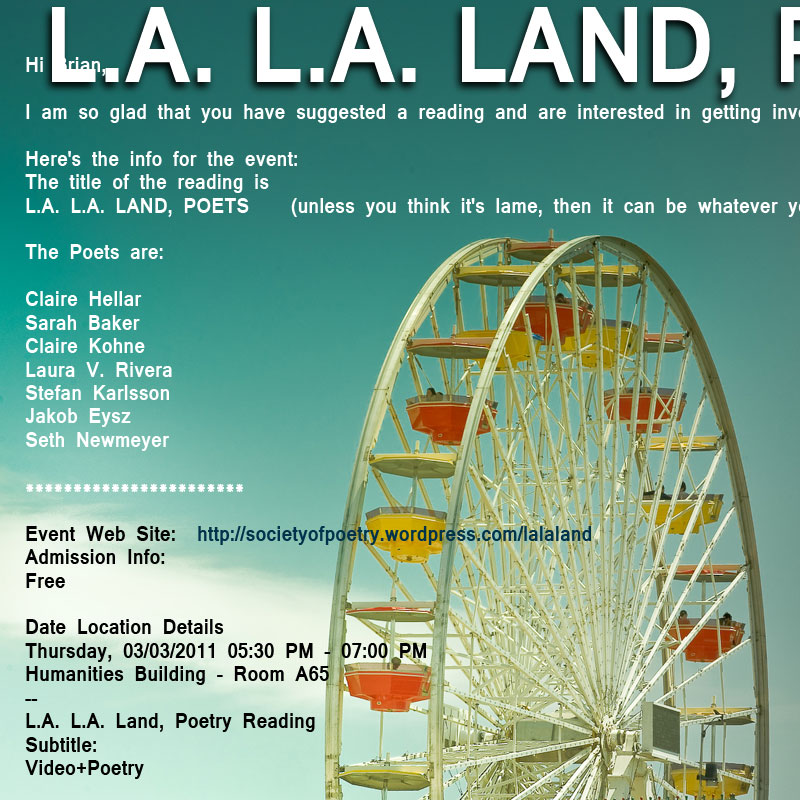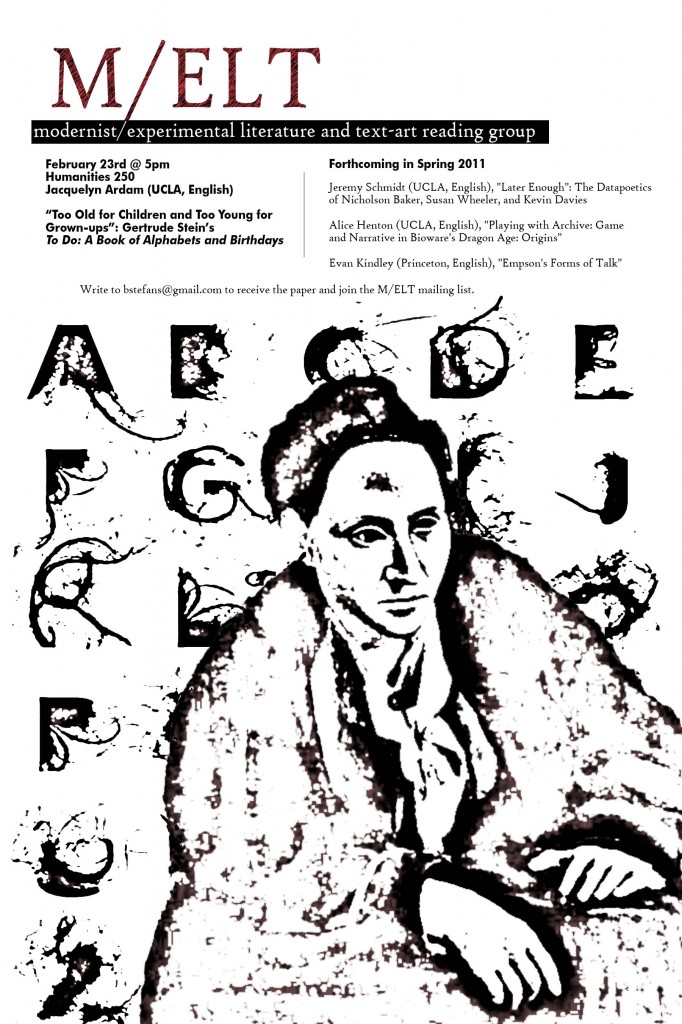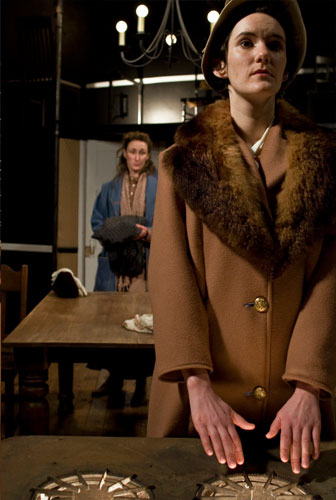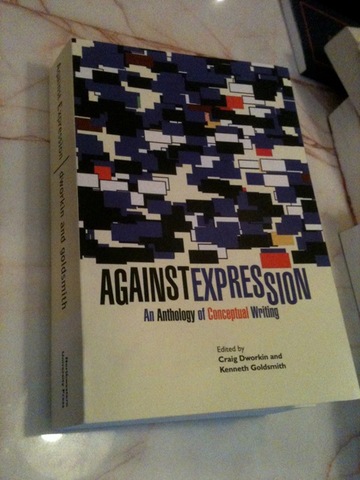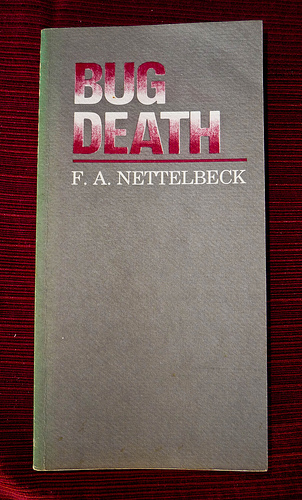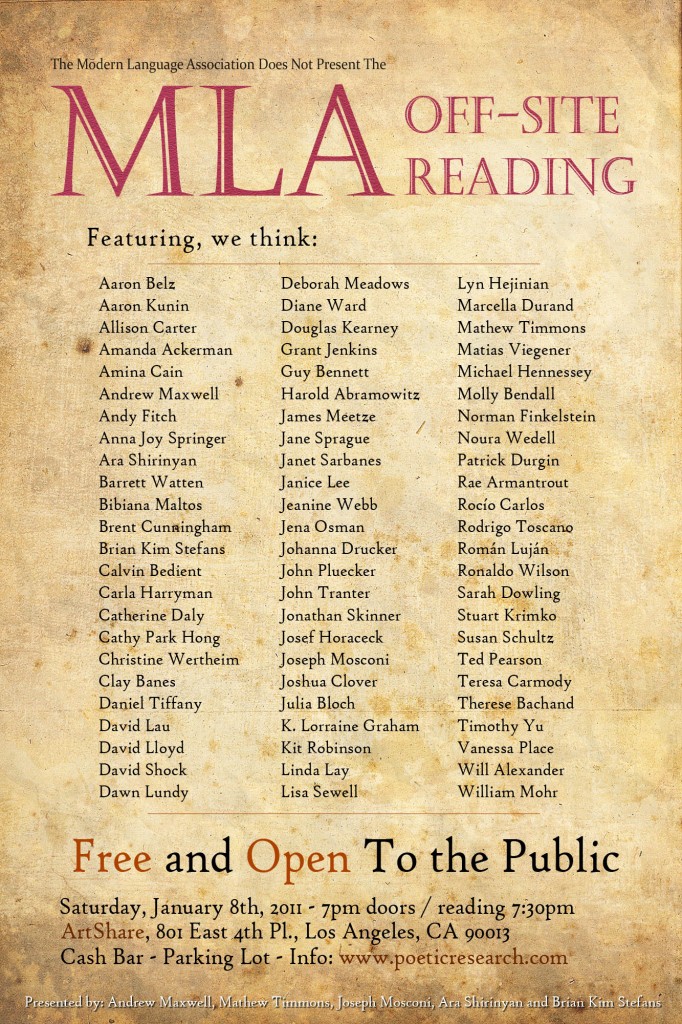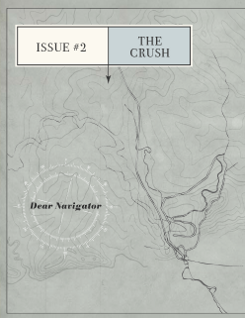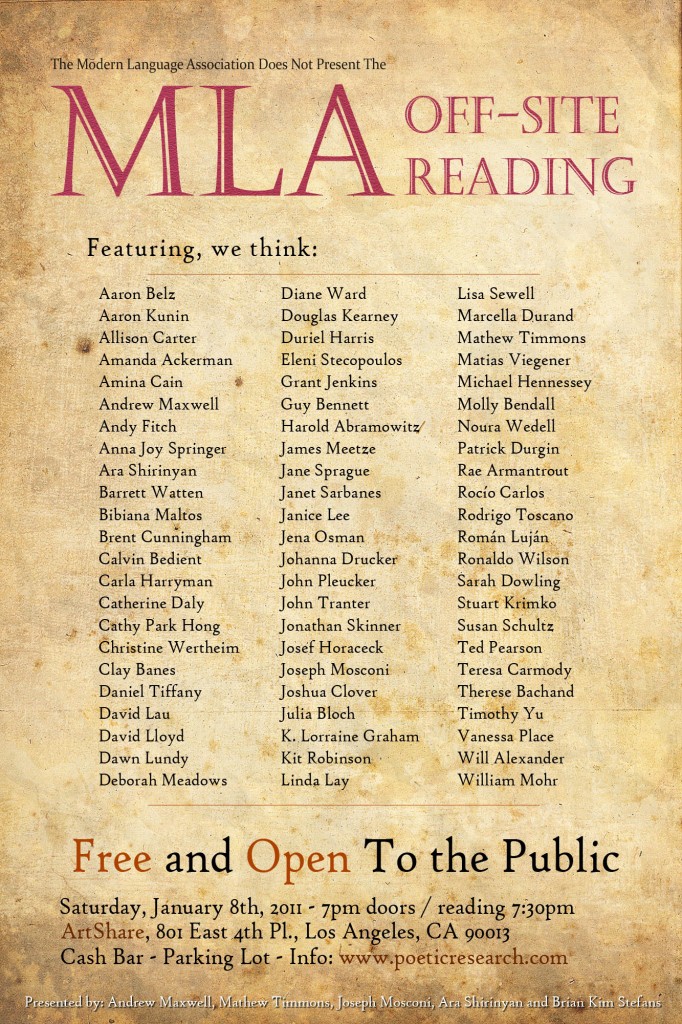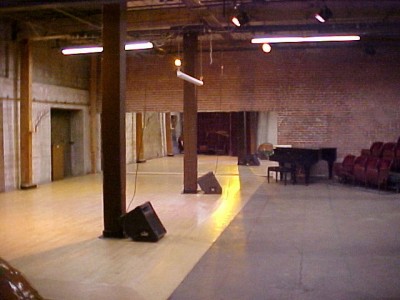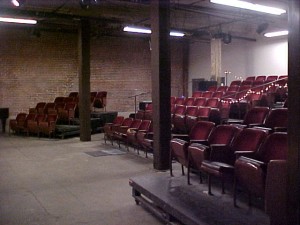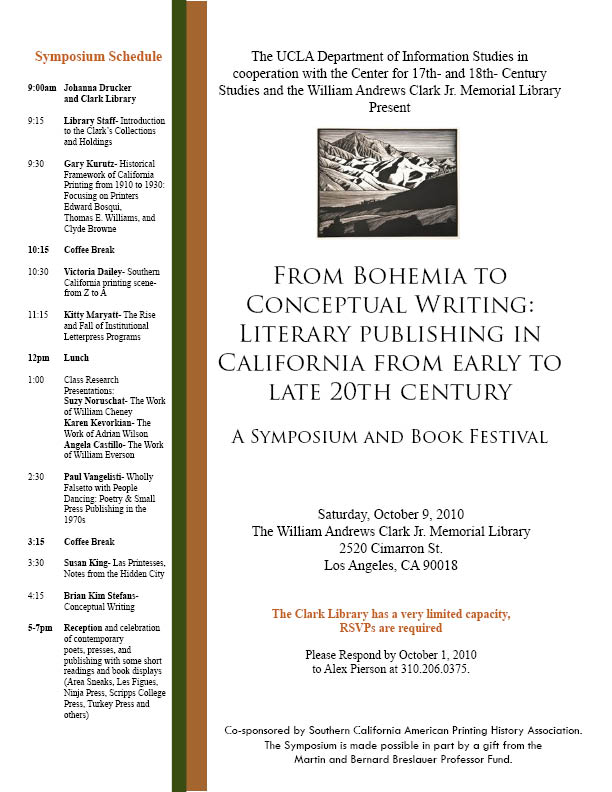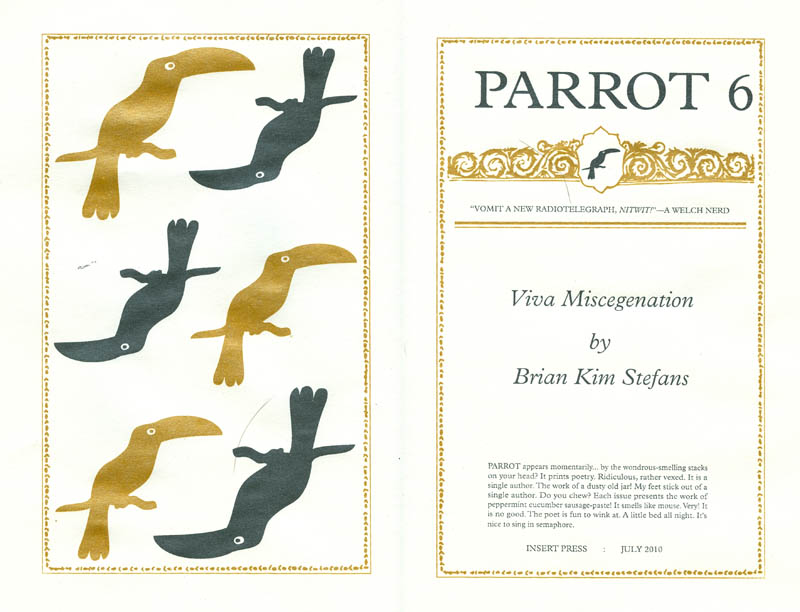Sat 12 Feb 2011
Wed 9 Feb 2011
M/ELT: Modernist/Experimental Literature and Text-Art Reading Group
Posted by bstefans under Announcement , M/ELTNo Comments
I’d like to announce a new inter-departmental UCLA student reading group focused on the writing and research of graduate students investigating “modernist†(i.e. anything roughly after 1850 or so, depending on language) and/or “experimental†(i.e. anything non-normative, purposefully or not, that reflects emergent formal or aesthetic features) literature and text art. Oh, by “text art,†I mean any form of art production that has a strong textual component, including performance, painting, film, digital text-art and video games.
I am patterning this group on the Americanist Research Colloquium that Christopher Looby (English) conducts, in the sense that papers will be distributed to interested parties via email before the sessions, and not be “presented†in person. Sessions will be given over entirely to discussion of the paper. The main task of the reading group would be to critique standard, page-based academic productions – namely, the essays that you would hope to have published in peer-reviewed journals – but with an additional emphasis on inter-departmental information exchange. This might seem “retro†given that I am a Digital Humanities Professor, but hiring and promotions in the academy today is still largely based on the journal article, and it is, indeed, a most convenient genre for critique in brief, informal settings.
Participants would be invited to present or attend from any number of departments, including Art History, Music, Philosophy, Film, Television and Media, and Design / Media Arts and the Humanities, from a variety of languages and sub-disciplines. I already have four students who are interested in presenting, and hope to have a schedule together soon for the remainder of the present quarter and Spring. Eventually, I would also invite scholars from Southern California (whoever would travel cheaply or for free) to present their recent, unpublished writing for critique by students (and myself).
I’m also arranging to have events modestly catered, so that they’re nice social events to assuage the loneliness of being an impoverished, under-appreciated graduate student.
Please drop me an email at bstefans@gmail (not my humnet address, as I find it difficult to organize large volumes of email there) if you are interested in being on our mailing list.
Brian Kim Stefans
Assistant Professor, English
___
M/ELT: modernist/experimental literature and text-art reading group
First meeting:
February 23rd @ 5pm, Humanities 250
Jacquelyn Ardam (UCLA, English)
“Too Old for Children and Too Young for Grown-upsâ€:
Gertrude Stein’s To Do: A Book of Alphabets and Birthdays
Forthcoming in Spring 2011
Jeremy Schmidt (UCLA, English), “Later Enough”: The Datapoetics of Nicholson Baker, Susan Wheeler, and Kevin Davies
Alice Henton (UCLA, English), “Playing with Archive: Game and Narrative in Bioware’s Dragon Age: Origins”
Evan Kindley (Princeton, English), “Empson’s Forms of Talk”
Mon 7 Feb 2011
Hey Bickerstaff,
My friend, it’s sad to see
You set your leaky pen to poetry,
Or tax WordPerfect (stet), or noble daughter
In vain to fix to sheet what you shouldn’t oughter
With each spent punkt – indeed, to read
That vision, melody, verse – outfoxed the deed.
If poems came to all who blindly trust,
Your cleric’s job, my poet’s, would be dust.
Of course, some old books are still worth a shelf,
A 3-foot one, a 7.5, or even twelf,
To keep the “canon†steady (thereon the brood
Of English profs can safely screw the bulb).
The war of mods and ancients is not old,
It’s ancient – spawns dark rings each time retold,
Thereby assuring children grab their mittens
Or iPhones, iHats, whatev – when its tale threatens.
For the past’s a playground, we are merely players;
The past collides with us like blind surveyors
(Lacking the requisite marks), overruns our glens
As Hurricane Katrina New Orleans,
Re-zoning lands, ignoring a feeble FEMA
And makes of the present past, and the past prima.
Words once rich, like “hella,†“refudiateâ€, and “lolâ€
Soon rust, unpractised, in that cave where Grendel fell.
The past becomes opaque when fixed like stone,
The “great names†weigh like Rushmore’s pantheon;
A leper colony’s walls conceal their riches,
The names themselves the uprights, beams and ditches.
Release the past to play! of the present, cease
To demand, as sign of health, enforced disease
Of chaining flux to stone, or of voyants ranging –
The present knows no truth but that it’s changing.
And why should students look to us to tell
Them what to read, when each home library’s full
Of Butler, Roth, Ellison, Stoppard, Barth-
Elme, Hurston, Parks, Delillo, Siebald, and Barthes?
Berryman, Ashbery, Ash, Doonsebury and Muldoon?
Doesn’t every home stack these besides New Moon?
A bookstore is a daunting place to be,
And sans a dot com’s recs, one opts for coffee.
Despite the many pasts the present rends,
As many rise to amplify its sense.
No need to mourn the L.F.M.’s long demise,
Already, a B.F.F. opens its eyes,
A major that can house the Major, but sings
In poly-tones, like the ‘pillar’s rainbow wings.
In hipper slang, we’d call this Major virtual,
(He already is, some say – in league with Grendel).
So, this is not some tale from Swift, no clique on clique,
The past is still in English, or “Englishes,†but not Greek.
Perhaps it is a war of ying and yang,
That swirls like mocha java to sate our pangs.
To Jameson, the present’s pastless, so we look back
At nichts – the past should aim to soothe the lack.
Thus, against the glitz, we’ll embrace, “forever†friends
– No candle burns as bright from half its ends.
Love,
Th3 4ng3l 0f H1st0ry
Sat 5 Feb 2011
Open Letter to ¡Sataristas!, Tim Robbins and the Actors Gang
Posted by bstefans under Banter[2] Comments
Dear ¡Sataristas!, Tim Robbins and the Actors Gang,
Thank you so much for the performance yesterday (February 2nd, 2001), and I think it’s a generous thing you and the Actors Group are doing by having a free performance once month in such a nice theater, with an inexpensive bar, and inspired by socially progressive themes.
I think I’m pretty aware of what the tenor of your project last night was – to somehow confront the history of racism in the United States, a history which persists to today, with over-the-top absurdist humor that bordered on tasteless, kind of a South Park-meets-lefty-rally-of-the-60s – but I’m afraid you missed the mark.
I didn’t particularly mind the singer songwriter – I only got to see two of his numbers, the one about how spelling out the N-word is ok for white people, and the one about stereotypes about race and penis size. The only real problem there was how incredibly unoriginal the material was. I couldn’t see this being of any use to an audience outside of the largely white, upper middle-class folks that attended the event last night. It was coterie humor disguised as progressive, transgressive humor, taken from the trash bin of a mediocre cable channel. But the two songs were brief, and you could take it or leave it.
The opening act, a mime in white-face performing a greatest-hits list of African American history, was very skillfully done, and certainly made for one of the most gripping examples of old school mime I’ve ever seen. But again, it seemed particularly dated, and the politics of the history presented incoherent and troubling. The mime started with a scene of Africans in Africa (using spears), who are then shackled and led into slavery. It then moves through a series of canonical vignettes – slaves picking cotton in the fields, the origins of the blues, the origins of Rock and Roll, Rosa Parks taking a seat on a bus, Civil Rights marches, something about basketball players, Rodney King, the OJ Simpson trial (with grisly depiction of the murders), Michael Jackson’s stardom, finally ending in the election of Barak Obama as President. Most of these vignettes were punctuated by the image of the protagonist being hand-cuffed or shackled and being led away, usually to knowing laughter from the audience.
I missed several of the allusions, but it strikes me that, for the most part, the depictions were of slaves, criminals, athletes and musicians, with the only figures of social agency being those of the anonymous civil rights protesters and Rosa Parks. I didn’t see any intellectual figures, or any political or cultural figures of ethical complexity who weren’t saintly, iconic African Americans – no Richard Pryors, Malcolm Xs, Toni Morrisons, Spike Lees or Tupac Shakurs. I didn’t see anything in the range of impersonations that could have possibly suggested that Barak Obama could be president today – it depicted him as merely arising out of the rabble of partying, sports and/or social discord. The final crowning moment of Obama’s presidency seemed quite ludicrous coming directly after the Jackson dance routine and the Simpson murder. Of course, this is a mime – I’m giving it greater attention than it probably deserves – but it was one that presented a complex history all in the service of a therapeutic (for white people) laughter. What does it mean to laugh at the O.J. Simpson trial in this context? What does it mean for a white mime to own and convey black history for a white audience? In Culver City, no less?
The comic strip artist, Kevin Knight, was very entertaining, and might have been the one thing in the evening that didn’t strike me as completely wrong. I’ll pass him up for now, as you can see his work on the web. I’d like to move quickly to what really inspired this letter.
I really got uncomfortable during the group shout-along, during which were projected slides and short video clips, along with the narrator (Paul Provenza?) asking the audience: “Is this racist?†The content of the slides was mostly images of signs and icons – “Blacks for Sale,†“Heebs Grocery,†and a bookshelf in the shape of a swastika hung at IKEA, an African American newsman showing a police sketch of a rapist that looks just like him, some commercial cartoon that depicted Mexicans with thick accents, etc. – that were probably created innocently, but which somehow conveyed a racist message. I suppose the goal in presenting them was to promote discussion, and to give a lot of people suffering from “white guilt†– the MC had expressly stated that the evening’s show was addressing black history month and was an outlet for white guilt – to demonstrate their lack of racism, or at least project through laughter their sense of the absurdity of racism, or at least their insider’s knowledge about how the sign systems of the world are encoded with racism, etc.
That’s all fine, but it should be noted that this form of conscience-cleansing is strictly a project of a particular class of people, and of a particular color, and even, I might add, of a particular geography. I’m new to Los Angeles, so I’m still acclimating myself to how the general populace here relate to each other in terms of race and class, but I was struck at how insulated most of the audience seemed to be from the people, not to mention the culture, of the non-white upper middle class (even as it appears on television!), and how the events of the evening reflected a particular anxiety about having no physical or cultural interaction outside of their (admittedly large and powerful) coterie.
The most distressing moment was when a video was projected of tiny gray monkeys having sex on tree branches, with some racist “black†voices dubbed over it, dramatizing the sex drive of the lead, horniest monkey, all to huge laughter from the audience. (I feel like heard the nefarious laughter that Dave Chappelle heard that fateful day, which drove him out of show business for a months.) After the clip, the URL of the creator of the movie was projected (I don’t remember who it was, but I didn’t recognize it), I assume to point out that this was the creation of a particular individual deserving of group enmity, rather than an accidental find on the internet. I didn’t quite see the distinction, though.
The question was, of course, then asked by the host: “Is this racistâ€? Of course it was racist – that was probably the only thing that was racist that was projected that evening (the majority of the images being of double-entendres and accidents of juxtaposition) – and it elicited some pretty excited laughter. It being a video, this laughter went on for some time before we got the “reveal†– the name of the creator. I have no idea why the video was shown, as it didn’t share several of the features of the other “accidental” racist imagery and text. What was most racist, however, was the laughter of the audience – they laughed exactly when they were supposed to, at the cue of the creator – or at least it convinced me (rightly or not) that most of the people in the room were, indeed, racists. I don’t believe that, but the event and context created this impression.
What I’m most confused by is the point of the entire exercise. Was the “Is this racist?†shout-along intended to shame all of the participants to fall in line with some particular view of what racist imagery is? Was it to project, as I suggest above, the group’s sense of themselves as confirmed non-racists? Was it a chance for white people to sit in the same room with a few black and Asian people (invited attendees and performers – I didn’t see any black or Asian people in the audience, and if there were, they were in very small numbers) and share some moments of mutual, therapeutic discomfort?
Whatever the answer is, I’d like to stress that, for the most part, I can’t complain. It’s hardly my position to judge what a group of people do in a room together to help them deal with the conflicts of the world, or their own interpersonal difficulties, or their difficulties with dealing with their prejudices. This was clearly an event of some importance to a particular group of white people in a particular part of the world, and not the event of universal relevance that it was billed to be (I do think it’s a common mistake among “enlightened,†well-intentioned white liberals to think that their perspective is universal and unbiased, rather than culturally specific like everybody’s else’s is).
It probably should not have been an open event, though, as I stumbled into it quite innocently, hoping to see some socially searing comedy. The event reflected an incredibly unsubtle, dated, and largely oblivious view of race relations in our culture, which, while largely imperfect, has been rendered so much more complex by artists, politicians, cultural events and, most importantly, comedians over the past decades that it can’t be reduced to antique folk songs and slide shows – especially not hour long slide show with abrasive shout-alongs! This type of humor might have been news to Archie Bunker (maybe even Meathead), but not to those of us who actually walk the streets of this, or any, city.
When I and my friend got up to leave – she had to use restroom, and we were both very hungry – a member of the audience shouted to us, knowingly I guess, “Oh, we’ve offended the Asians!†(Or, “The Asians are offended,” I can’t remember which.) I haven’t been referred to as “the Asian†in a long time, and because, in fact, I am only half-Asian, I am often in the position of telling other Asians that, indeed, I am Asian in some way. But to this fellow I was “the Asian,†largely contextualized, even over-determined, by some of the imagery that was being projected on the screen (we actually waited until the Asian section of the images passed before getting up, in fear of drawing attention to ourselves).
I can’t say that I was offended by this man or felt any danger, but it was quite presumptuous of him to think that I was engaged in this group lynch-mob mentality – lynch the racists! – even so much as to need to reject it. I found the event, at best, silly and unfortunate, and would just have liked to have been left with my thoughts, which were more complex than could have been shouted out into this room. He could simply not imagine how wrong I thought the whole event was — the negation of an “Asian” seemed not within his imagination.
Maybe I was expecting too much by thinking I’d see at this event social humor on the caliber of Richard Pryor or Lenny Bruce or even Chelsea Handler (who I think is brilliant) – gritty stuff that walks the fine line between tasteless and illuminating, but which every step of the way seems somehow in touch with “on the ground†realities as they are played out every day by people living, dying, falling in love, having babies, liking or disliking each other, sleeping with each other, and indeed laughing at each other. Maybe the ¡Sataristas! – a highly pretentious name, in my opinion – just aren’t funny, or knew what to aim at but just didn’t get there. I guess I’m concerned that the approach and viewpoints expressed there are the status quo among the white (and non-white) middle class here in Los Angeles, and that kind of frightens me. I don’t know what it would take to bring about a cultural upgrade, but given your visibility and relative power to stage your views, please try!
Sincerely,
Sun 30 Jan 2011
My latest proposal for the Public School, Los Angeles chapter.
This course is geared toward writers and performers who want to workshop experimental theater texts, including already published and premiered plays.
There is no set definition for what “experimental” means. I tend to favor a lot of the writing coming from Mac Wellman and the group of younger writers who engage in his brand of “pataphysical theater,” including Young Jean Lee, with whom he edited the excellent anthology New Downtown Now, published by University of Minnesota Press. I’m also a big fan of the Wooster Group, but most of the best work I’ve seen is by very small troupes in NYC, like The Theater of a Two-Headed Calf and The National Theater of the United States of America. Basically, a reading list could be based on anything that is happening in theater today that is not expressly commercial or realist in the common senses of the word. We could also look at Youtube videos and assemble some sort of library of videos of groups and writers we are interested in.
I’d also like to look at some British playwrights like Edward Bond and Caryl Churchill, and especially like to figure out what experimental theater exists in Los Angeles (you can see my blog, Free Space Comix, for my attempts to collect links about this).
The definition of “theater” itself can be rather open, especially in LA, which has such a strong tradition of performance art. My sense is that theater should, at its very base, tell a story, or appear to do so, rather than present something in a purely sculptural or phenomenal way. That is, performance art is about historical events — singular, not-to-be-repeated happenings — whereas theater seems to rely on artifice, stagecraft, the creation of ritual or narrative — perhaps “memory” — spaces, that are valuable because of their very repeatability. The writer/performer distinction seems to rarely exist in performance art, whereas it’s central to the interesting dynamic of theater, even if the writer does indeed direct or perform. But there’s no reason to essentialize.
In any case, I’d like to create a workshop in which we can do exercises in creating new interesting things for actors and directors to do. We can have readings, and play around with each others’ texts. Ultimately, I’d like to see a staging of these works.
I certainly don’t have, or want, to be “workshop leader” every week — anyone who has interesting ideas for exercises, or has some special knowledge about contemporary theater, and wants to lead a workshop should do it.
Sat 29 Jan 2011
Against Expression: An Anthology of Conceptual Writing
Posted by bstefans under AnnouncementNo Comments
Against Expression: An Anthology of Conceptual Writing
Edited by Craig Dworkin and Kenneth Goldsmith
Price $45
ISBN 0-8101-2711-3
Year 2011
Pages 608
Binding perfect bound
Illustration colour illustrated cover; text only inside
Dimensions 152 x 228 mm
Publisher Northwestern University Press
In much the same way that photography forced painting to move in new directions, the advent of the World Wide Web, with its proliferation of easily transferable and manipulated text, forces us to think about writing, creativity, and the materiality of language in new ways.
In Against Expression, editors Craig Dworkin and Kenneth Goldsmith present the most innovative works responding to the challenges posed by these developments. Charles Bernstein has described conceptual poetry as “poetry pregnant with thought.”
Against Expression, the premier anthology of conceptual writing, presents work that is by turns thoughtful, funny, provocative, and disturbing. Dworkin and Goldsmith, two of the leading spokespersons and practitioners of conceptual writing, chart the trajectory of the conceptual aesthetic from early precursors including Samuel Beckett and Marcel Duchamp to the most prominent of today’s writers.
Nearly all of the major avant-garde groups of the past century are represented here, including Dada, OuLiPo, L=A=N=G=U=A=G=E, and Flarf to name just a few, but all the writers are united in their imaginative appropriation of found and generated texts and their exploration of nonexpressive language.
Against Expression is a timely collection and an invaluable resource for readers and writers alike.
Authors include: Monica AASPRONG, Walter ABISH, Vito ACCONCI, Kathy ACKER, Sally ALATALO, Paal Bjelke ANDERSEN, David ANTIN, Louis ARAGON, Nathan AUSTIN, J. G. BALLARD, Fiona BANNER, Derek BEAULIEU, Samuel BECKETT, Caroline BERGVALL, Charles BERNSTEIN, Ted BERRIGAN, Jen BERVIN, Gregory BETTS, Christian BÖK, Marie BUCK, William S. BURROUGHS, David BUUCK, John CAGE, Blaise CENDRARS, Thomas CLABURN, Elisabeth CLARK, Claude CLOSKY, Clark COOLIDGE, Hart CRANE, Brian Joseph DAVIS, Katie DEGENTESH, Mónica DE LA TORRE, Denis DIDEROT, Marcel DUCHAMP, Craig DWORKIN, Laura ELRICK, Dan FARRELL, Gerald FERGUSON, Robert FITTERMAN, Lawrence GIFFIN, Peter GIZZI, Judith GOLDMAN, Kenneth GOLDSMITH, Nada GORDON, Noah Eli GORDON, Michael GOTTLIEB, Dan GRAHAM, Michelle GRANGAUD, Brion GYSIN, Michael HARVEY, H. L HIX, Yunte HUANG, Douglas HUEBLER, Peter JAEGER, Emma KAY, Bill KENNEDY and Darren WERSHLER, Michael KLAUKE, Christopher KNOWLES, Joseph KOSUTH, Leevi LEHTO, Tan LIN, Dana Teen LOMAX, Trisha LOW, Rory MACBETH, Jackson MAC LOW, Stéphane MALLARMÉ, Donato MANCINI, Peter MANSON, Shigeru MATSUI, Bernadette MAYER, Steve MCCAFFERY, Stephen MCLAUGHLIN and Jim CARPENTER, David MELNICK, Richard MELTZER, Christof MIGONE, Tomoko MINAMI, K. Silem MOHAMMAD, Simon MORRIS, Yedda MORRISON, Harryette MULLEN, Alexandra NEMEROV, C. K. OGDEN, Tom ORANGE, PARASITIC VENTURES, George PEREC, M. NourbeSe PHILIP, Vanessa PLACE, Bern PORTER, Raymond QUENEAU, Claudia RANKINE, Ariana REINES, Charles REZNIKOFF, Deborah RICHARDS, Kim ROSENFIELD, Raymond ROUSSEL, Aram SAROYAN, Ara SHIRINYAN, Ron SILLIMAN, Juliana SPAHR, Brin Kim STEFANS, Gary SULLIVAN, Nick THURSTON, Rodrigo TOSCANO, Tristan TZARA, Andy WARHOL, Darren WERSHLER, Christine WERTHEIM, WIENER GRUPPE, William Butler YEATS, Steven ZULTANSKI, Vladimir ZYKOV
Sat 15 Jan 2011
Below are the results of my internet searches and Facebook status update responses concerning “experimental” or “underground” theater and dance in Los Angeles. Not all of this could be called “experimental” — the Blank Theater Company, for example — but I’ve included them just for my own perverse reasons.
I’ve seen nothing by most of these writers, directors or groups, except for things ar REDCAT, notably a production by my brilliant friend Melanie Rios Glaser and her company The Wooden Floor.
I’m excited to see Alice Tuan here. I had never heard of her, but according to her biography, she’s done work with the Flea back in New York. Most of my best theater experiences were through the Flea and the writers associated with Mac Wellman and the “Little Theatre” series curated by Jeffrey Jones, so I’m interested in seeing what she does. She also studied with Paula Vogel, with whom I studied (for one semester) out at Brown.
If you know of any other writers, directors or organizations that belong here, please let me know!
Alice Tuan / CalArts
http://directory.calarts.edu/directory/alice-tuan
Anatomy Riot (Show Box)
http://www.myspace.com/anatomyriot
Bootleg Theater
http://www.bootlegtheater.org/
Bryan Reynolds / Transversal
http://www.bryanreynolds.com/
CalArts School of Theater
http://theater.calarts.edu/
Circle X Theatre Co.
http://www.circlextheatre.org
Circus Theatricals
http://www.circustheatricals.com/
City Garage
http://www.citygarage.org/
Cornerstone Theater Company
http://www.cornerstonetheater.org/
Diavolo Dance Theater
http://www.diavolo.org/
Heidi Duckler Dance Theatre
http://heididuckler.org/contact/index.html
Highways Performance Space and Gallery
http://www.highwaysperformance.org/
Hollywood Fringe Festival
http://www.hollywoodfringe.org/
Mady Schutzman / CalArts
http://directory.calarts.edu/directory/mady-schutzman
Meg Wolfe
http://www.myspace.com/dancemegwolfe
Melanie Rios Glaser / The Wooden Floor
http://www.saintjosephballet.org/view/default
Not Man Apart Physical Theatre Ensemble
http://www.notmanapart.com
Odyssey Theatre Ensemble
http://www.odysseytheatre.com/
Orphean Circus
http://orpheancircus.com/
Poor Dog Group
http://www.poordoggroup.com
Psatticus Productions
http://www.psittacusproductions.org/
REDCAT
http://www.redcat.org/
Rogue Machine
http://roguemachinetheatre.com/word press
Sacred Fools
http://www.sacredfools.org/
Simone Forti
http://en.wikipedia.org/wiki/Simone_Forti
Son of Semele Ensemble
http://www.sonofsemele.org
Susan Simpson / The Manual Archives
http://www.manualarchives.org/
The Blank Theater Company
http://www.theblank.com/
The Actors Gang
http://www.theactorsgang.com
The SpyAnts Theater Company
http://www.thespyants.com/
The Underground Theater Online
http://www.undergroundtheater.com/Home.html
Theatre 68
http://www.68centcrew.com/
Theatre of Note
http://www.theatreofnote.com/
Travis Preston / CalArts
http://directory.calarts.edu/directory/travis-preston-0
Upright Citizens Brigade
http://losangeles.ucbtheatre.com/
Zombie Joe’s Underground Theatre Group
http://zombiejoes.homestead.com/
Sat 15 Jan 2011
Writing becomes Eclectric: a symposium on electronic literature
Posted by bstefans under AnnouncementNo Comments
This symposium brings together many figures from the world of electronic literature to discuss its practices, concerns, and future. The event will feature a keynote by Rita Raley on the socio-political potential of e-Writing, lectures by Geoffrey Ryman, Artur Matuck, Brian Kim Stefans, as well as presentations and discussions on the interpretation of eliterature by distinguished scholars field.
Thursday January 27th 2011
1pm – 7pm
Calit2 Theater, Atkinson Hall
University of California San Diego
Voigt Drive, La Jolla, CA
Tentative Schedule:
12pm – Technical check
1:00pm Sheldon Brown – Introduction (10mins)
Keynote: Rita Raley (~30mins + 15min Q&A)
2:00pm Geoffrey Ryman via Skype (30mins)
2:30pm Artur Matuck (~30mins + 15 min Q&A) text based
3:15pm – 3:30pm – Break
3:30pm Brian Kim Stefans (~30mins + 15mins Q&A)
4:15 – Interpretations (3×15 mins each + 15 mins Q&A)
Yra van Dijk
Beat Suter
Mark Marino and Jeremy Douglass
5:15pm – 5:30pm – Break
5:30pm Discusssion Panel
Sheldon Brown – moderator
Liz Losh
Anna Springer
Jeremy Douglass
6:30pm Readings and curated works.
We have also scheduled a technical check period between 12pm and 12:45pm on the day of the event. It is the only opportunity for you to test that your computer/video/audio will look & sound as you would like in the theater.
Maps and Directions to the event can be found here: http://crca.ucsd.edu/views.php?id=5
Tue 11 Jan 2011
Chapters In Los Angeles Poetry (at the Public School)
Posted by bstefans under Los Angeles PoetryNo Comments
I had insomnia last night, and in the midst of it proposed this discussion group at the Public School here in Los Angeles. If you don’t know, the Public School is a forum for spontaneous informal courses and discussion groups. You propose a course (one which you would either teach, attend, or teach a few sessions of), and if there is enough interest over time, a time is agreed upon and the course moves forward. We’ll see who (or what!?) bites.
The Poetic Research Bureau is housed in the same space in Chinatown, so if this goes forward, it would probably be considered a PRB-sponsored project as well.
Chapters In Los Angeles Poetry
I’ve been doing research on poetry in Los Angeles from the late 19th century to the 70s, mostly concentrating on radical or experimental trends. Los Angeles doesn’t have a strong “tradition” or sense of continuity with its past “cultures” of poetry — moments happen, linger, then disappear. I’d like to rediscover and examine some of these moments, since even just scratching the surface, I’ve come up with some interesting material that is practically unknown to the general reader.
Each week, I would send out a .pdf of a set of poems and poets, along with whatever useful essays, interviews and other secondary material I can find. The discussion would be largely informal, and I invite everyone to bring laptops so that we can actually do research as we discuss. Some issues will include simply discerning the “poetics” of that particular writer — who they might have been influenced by, what they have added to — the content of the writing, the moral/ethical stances, the success or failures, etc. — whatever it is that makes the poem unique (failed poems can be very unique).
We’ll also play around with questions of what a “Los Angeles poet” is — several of these writers didn’t live here past their 30th years, and a few didn’t even live here ten years (I’d like to include Robinson Jeffers and Bertolt Brecht in the discussion).
Among the groupings I’ve come up with: the “Little Caesar” crowd at Beyond Baroque, so named after the journal published by Dennis Cooper — who would go on to become famous for his explicit, gay, often sadistic fiction. Amy Gersler and Bob Flanagan (“Slave Sonnets”) was part of this scene, as well as the members of X for a while. Another group is those folks centered around Thomas McGrath, a leftie who moved here to take a job at Los Angeles College and was fired during the McCarthy era. He stayed around and mobilized a pretty interesting group of writers. They would be the ones to host Allen Ginsberg’s first reading in LA. A little later, a radical “New American” kind of scene sprung up in Venice — the “holy barbarians” — where poets like Stuart Perkoff and John Thomas lived, and the Situationist Alexander Trocchi wrote parts of Cain’s Book.
Early in the century you had the singular figure, Nora May French, who, after writing a small group of highly wrought poems, shot herself in despair over a love affair. She and a small group of primarily female poets seem to be the earliest (outside of the Spanish writing, which I’d also like to look at) sophisticated poetry here. We’ll also take a look at some of the other poets who seem to have something to do with the poetics of Bukowski, but who are actually more extreme — F. A. Nettlebeck, author of the book-length Bug Death is one example (though he left the area around the time of its publication) — and who could make more claims to being “avant-garde” formally.
Well, the list goes on. I also want to look at people normally associated with art — Ed Ruscha, Allen Ruppersberg and Guy de Cointet — and theater and dance, such as Brian Reynolds, Simone Forti and Erik Ehn, though he’s since left the area. In this way, I’d like to expand the idea of what constitutes “poetry,” especially in light of the interesting work being done by present-day poets, conceptual writers, artists and performers in LA.
Mon 10 Jan 2011
Here is a short list of books available for free download online that I’ve discovered over the past month (along with a few oldies). Just type in “pdf” after a book you are looking for and there are fair, if not great, chances you’ll find it. Not that I’m trying to kill the publishing industry… I’m just finding it quite easy to read and annotate chunky texts like this on my tablet (my penmanship sucks).
There are several titles at re.press that are available for free download, including a volume of Hegel’s introductions. I’d be interested in compiling a list of publishers that make most or all of their material available online. Please let me know!
- Marcus Boon, In Praise of Copying
- Paul Virilio, The Information Bomb
- Lev Manovich, Software Takes Command
- Quentin Meillassoux, After Finitude: An Essay on the Necessity of Contingency
- Graham Harman, The Prince of Networks: Bruno Latour and Metaphysics
- Florian Cramer, Words Made Flesh: Code, Culture, Imagination
- Bruno Latour, We Have Never Been Modern
- Michael Hardt & Antonio Negri, Empire
- Lawrence Lessig, The Future of Ideas
- Levi Bryant, Nick Srnicek & Graham Harman (editors), The Speculative Turn: Continental Materialism and Realism
- Robert Duncan, The H.D. Book
- Andrew Benjamin and Charles Rice (eds.), Walter Benjamin and the Architecture of Modernity
Tue 4 Jan 2011
And who said conference poetry wasn’t sexy? You say MLA. We say MLAwesome.
Zero-sum speed-sport pachinko-style poetasty. Everything poetry is not supposed to be –– for four-and-a-half hours!
This is the shadow convention. Screw the well-lit spaces. Guidebook for conventioneers ahead.
Doors open at 7:00, the reading will start at 7:30.
Artshare
http://artsharela.org
801 East 4th Pl.
Los Angeles, CA
Poets will read for 3 minutes (or less); we place violators on the subway to the sea, MTA-guaranteed, by which we mean they shall never arrive. We have to be out of the venue by midnight, so windbags will be haters. If it sounds like a puptent happening, get this: it is a proper theater, so at least there are no chairs to fold!
There is a parking lot, and during the event there will be an inexpensive cash bar, but we have no other details on the space. It looks really great in the photos.
Did we mention there’s a grand piano?
Visit the Poetics Research Bureau for more details.
Wed 29 Dec 2010
DEAR NAVIGATOR
HTTP://WWW.SAIC.EDU/DEARNAVIGATOR
The School of the Art Institute of Chicago and the Master of Fine Arts in Writing Program, in conjunction with the DEAR NAVIGATOR editorial staff, are proud to announce the second (double!) issue of DEAR NAVIGATOR, an electronic magazine of contemporary art + writing, featuring emerging + established artists from around the globe.
[Because winter isn’t cold enough, we’re striking again while the iron is hot—with twice the content in our first double issue!]
Bolstered by a distinguished board, DEAR NAVIGATOR creates a forum for innovative writing that works as art object, critical opus, interdisciplinary essay, poetic form, meta-text, and philosophical offering. Housed by the MFA in Writing Program at SAIC, DEAR NAVIGATOR appears quarterly and electronically, publishing a handful of established and up-and-coming writers per issue, while shepherding associated projects, including curated reading and performance series.
We couldn’t be more delighted to announce the debut of Issue 2: The Crush, which features new multidisciplinary work from:
• Eric Baus
• Susan Daitch
• Hamdy el-Gazzar (translated by Humphrey Davies)
• William Fuller
• Kristi Maxwell
• Nick Montfort and Stephanie Strickland
• Eleni Sikelianos
• Zachary Schomburg
• Kate Zambreno
Follow us on Twitter: @dearnavigator
Fan us on the FBOOK: Dear Navigator
Join our email list: dn.writing@gmail.com
**
DEAR NAVIGATOR EDITORIAL BOARD:
Dan Beachy-Quick, Kenneth Goldsmith, Matthea Harvey, Yusef Komunyakaa, W. Martin, Peter Orner, Vanessa Place, Patricia Smith, Brian Kim Stefans, Saviana Stanescu, and Cole Swenson
MASTHEAD : :
Editor: Elizabeth Metzger Sampson
Curator and Content Editor: Kristi McGuire
Editor-at-Large: Chris Cuellar
Associate Editors: Rebecca Elliott, Heather McShane, Edmund Sandoval, and Colin Winnette
Spiritual Advisor: Sarah Archer
: : END TRANSMISSION + STAY TUNED
(HTTP://WWW.SAIC.EDU/DEARNAVIGATOR)
Tue 28 Dec 2010
Introduction to Electronic Literature: a freeware guide
Posted by bstefans under Banter , Essay[4] Comments
I’ve been working on a project based on my courses on electronic literature. I’ve been teaching it for over five years now, and am getting a sense of the texts that I use. However, I always feel like I’m building the class from the ground up every time, so I thought it would be cool to collect my materials into some sort of “anthology” to have on hand.
I also wanted to create a user-friendly, brief introduction to the field for people not in school, or who have no access to such a class. There are numerous places to find criticism and writing related to electronic literature, but they often contain such a huge amount of text that the newbie would not know where to start. Consequently, they are often very academic in discourse level, which is alienating to someone unfamiliar with the jargon.
This collection is intended to be for students, not my fellow artists and academics, but I hope there is something interesting to find in here for you as well. I’m sure we all have different approaches — for instance, I assign exercises in Scratch and Wix, which won’t be reflected in this list, and I tend to stay away from historical readings or computer science — but I’ve prowled several of your syllabi and websites in the creation of this list. So this can be seen as a continuing conversation.
This is a “freeware” anthology in that I only limited myself to works that were already available on the web. In a few cases, this might be in the form of bootlegs — sometimes it’s hard to tell what has been approved, since not everyone uses a Creative Commons license — but I limited myself to pieces that don’t require special privileges or subscription costs. (In one case, the essay works on my iPad but not laptop; in another, I thought it was freely available but it was not, but I’ve kept it in anyway since the author’s a friend of mine.)
I hope to edit a book to sell on Lulu for cost that will include primarily excerpts from the works, along with editorial glosses. The model is the “Documents in Contemporary Art” series, which are readable in a few days, as opposed to the often mammoth books on digital culture published by MIT (much as I like them).
The website that I am creating for this anthology will contain the essays in .pdf form (reset, since many of these pages are nearly illegible), a .pdf of the edited book with my editorial commentary, a page of videos I often use when teaching, a “ten week course” that is a series of essays, links and assignments based on my course, and other materials such as a bibliography, via Amazon’s “listmania” feature, of electronic literature books.
This is not a complete overview of the state of the field, or an attempt to create a “canon.” If the image here is skewed or flawed, it’s only because it’s meant to be a launching pad for an independent investigation of the genre, either as a scholar or artist. The fact of the matter is, there isn’t a whole lot of great writing on the works themselves — more of the e-lit writing is about its theory and potential — so I tried to include what I could. If you know of better deep readings of a particular e-literature piece, please let me know.
Inspired by the New Media Reader, edited by Noah Wardrip-Fruin and Nick Montfort, this selection is a mixture of theoretical texts, creative works, manifestos, critical readings, interviews, Wikipedia articles, encyclopedia entries, lists, blog posts, and other miscellany. It only includes work that can be included in a book (or a .pdf). Any feedback you have is welcome!
Foundations
- F. T. Marinetti, “Words in Freedom†(1913), “Geometric and Mechanical Splendor and the Numerical Sensibility†(1917?)
- Wassily Kandinsky, “Concerning the Spiritual In Art†(1913)
- Walter Benjamin, “The Work of Art in the Age of Mechanical Reproduction†(1936)
- Jorge Luis Borges, “The Garden of Forking Paths†(1941), “The Library of Babel†(1941) and “Pierre Menard, Author of Quixote†(1941)
- Eugen Gomringer, “From Line to Constellation†(1954); “The Poem as Functional Object†(1968)
- Noigandres (Augusto de Campos, Decio Pignatari and Haroldo de Campos), “Pilot Plan for Concrete Poetry†(1958)
- Susan Sontag, “Happenings: an art of radical juxtaposition†(1966)
- Stanford Encyclopedia of Philosophy, “The Turing Test†(2008)
- Larry Hauser, “Chinese Room Argument†(2001)
- Güven Güzeldere and Stefano Franchi, “Dialogues With Colorful Personalities of Early AI†(1995)
- Donna Haraway, “A Cyborg Manifesto: : Science, Technology, and Socialist-Feminism in the Late Twentieth Century†(1991)
- N. Katherine Hayles, “Virtual Bodies and Flickering Signifiers†(1993)
- Espen Aarseth, “Ergodic Literature†(1997)
- Lev Manovich, “Database as Symbolic Form†(1999)
- John Cage, album notes to “Indeterminacy: New Aspect of Form in Instrumental and Electronic Music†(1959)
- Jackson MacLow, “The Twin Plays†(1966)
- Sol Lewitt, “Paragraphs on Conceptual Art†(1967), “Sentences on Conceptual Art†(1969)
- Hakim Bey, “The Temporary Autonomous Zone†(1991)
- Charles Bernstein, “Poetics of the Americas†(1996)
- Ted Nelson and Tim Berners-Lee, “The Best Summary of My Work†(1999)
Writing Making Stealing
- Douglas Englebert, “Augmenting Human Intellect: A Conceptual Framework†(1962)
- William S. Burroughs, “The Cut-Up Method of Brion Gysin†(1978)
- Gilles Deleuze and Felix Guattari, “A Thousand Plateaus†(1987)
- Shelley Jackson, “Stitch Bitch†(1997); Mark Amerika, “Stitch-Bitch: An Interview with Shelley Jackson†(1998)
- Aram Saroyan, “Pages†(1969)
- mez, “_The Art of M[ez]ang.elle.ing: Constructing Polysemic & Neology Fic/Factions Online_“
- Rita Raley, “Interferences: [Net.Writing] and the Practice of Codework†(2002)
- John Cayley, “Writing on Complex Surfaces†(2005)
- Cox, Geoff, Alex McLean and Adrian Ward, “The Aesthetics of Generative Code†(2006)
- Marjorie Perloff, “Conceptualisms Old and New†(2007)
- Charles Bernstein, “Experiments†(1996-2010)
- Darren Wershler, “The Tapeworm Foundry, andor, the dangerous prevalence of imagination†(2000)
- Nick Montfort and William Gillespie, “2002: A Palindrome Story†(2002)
- Toadex Hobogrammathon, “Name: A Novel†(1995?)
- Bill Seaman, “Approaches to Interactive Text and Recombinant Poetics†(2004)
- Encyclopedia Britannica, “The Influence of Erwin Piscator†(2010)
- Edward Tufte, “PowerPoint Does Rocket Science–and Better Techniques for Technical Reports†(2005)
- Lawrence Lessig, “What Orrin Understands†(2001); Wikipedia, “Creative Commons Licenses†(2010)
- Kenneth Goldsmith, “A Week of Posts to The Poetry Foundation Blog†(2007)
- Mike Magee, Kasey Mohammed and Gary Sullivan, “The Flarf Files†(2003); Dan Hoy, “The Virtual Dependency of the Post-Avant and the Problematics of Flarf: What Happens when Poets Spend Too Much Time Fucking Around on the Internet†(2006)
Text Image Sound
- Situationist International, “Detournement as Negation and Prelude†(1959)
- Alice Becker-Ho, “The Language of Those in the Know†(1995)
- Internet Encyclopedia of Philosophy, “The Bakhtin Circle†(2010)
- Keith Obadike, “Blackness for Sale†(2001)
- Giselle Beiguelman, “Hacktivism? I didn’t know the term existed before I did it: An Interview with Brian Kim Stefans†(2003)
- Josh On, “From They Rule to We Rule: Art and Activism†(2002)
- Noah Wardrip-Fruin, “Regime Change & News Reader†(2004)
- Paul Chan, “The text you write must desire me: fonts as the penultimate interactive artform, second only to sex†(2001)
- John Cage, “Experimental Music†(1957)
- Brian Eno, “Generative Music†(1996)
- John Oswald, “Plunderphonics, or Audio Piracy as a Compositional Prerogative†(1985)
- Charles Bernstein, “Close Listening: Poetry and the Performed Word†(1998)
- Kurt Schwitters, “Ursonate,†score (1922-32)
- John Cayley, “Bass Resonance†(2005)
- Johanna Drucker, “The Art of the Written Image†(1998)
- Elaine Equi, “The Poetry of Ed Ruscha†(2004)
- Marjorie Perloff, “Screening the Page / Paging the Screen†(2006)
- Thom Swiss, “An Interview With Young Hae-Chang Heavy Industries†(1922); Jessica Pressman, “Reading the Code between the Words: The Role of Translation in Young-hae Chang Heavy Industries’s Nippon†(2007)
- Josh Spear, “Interview with Jason Nelson†(2010)
- Brian Kim Stefans, “An Interview with William Poundstone†(2002)
Reading Looking Doing
- Braulio Taveres, “Raymond Queneau†(1999); Raymond Queneau, “Yours for the Telling†(1967)
- Guy Debord, “Theory of the Derive†(1958)
- Roland Barthes, from “S/Z†(1973)
- Catherine Burgass, “A Brief Story of Postmodern Plot†(2000)
- Harry Mathews, “Histoire†(1988)
- Jill Walker, “Piecing Together and Tearing Apart: Finding the Story in afternoon†(1999)
- Shayna Ingram, “Reconsidering the Walls of Literature through Hypertext†(2008)
- Mikhail Epstein, “Hyper-Authorship: The Case of Araki Yasusada†(2000)
- Wikipedia, “mouchette.org†(2010)
- Nick Montfort, “Toward a Theory of Interactive Fiction†(2003)
- Roberto Simanowski, “‘Reading “Text Rain’†(2005)
- Stuart Moulthrop, “Pax, Writing and Change†(2008)
- David Rokeby, “The Computer as a Prosthetic Organ of Philosophy†(2003)
- Jesper Juul, “Games Telling Stories†(2001)
- Henry Jenkins, “Game Design as Narrative Architecture†(1999)
- Alex Galloway, “Social Realism in Gaming†(2004)
- David Young, “Interview with Erik Loyer†(2010)
- Alexandra Saemmer, “Ephemeral passages—La Série des U and Passage by Philippe Bootz: a close reading†(2009)
- Marjorie Perloff, “The Music of Verbal Space: John Cage’s ‘What You Say’†(2004)
- Peter Lunenfeld, “Towards Visual Intellectuality: The Mediawork Pamphlet Series†(2010)
Genre Jams
- Ulisses Carrion, “The New Art of Making Books†(1975)
- Robert Coover, “The Babysitter†(1969); “The End of Books†(1992)
- Bruce Andrews, “Electronic Poetics” (2002)
- Stephanie Strickland, “Born Digital†(2009)
- Christian Bök, “The Piecemeal Bard Is Deconstructed: Notes Towards a Robopoetics†(2001)
- Daniel C. Howe, “The RiTa Library†(2007?)
- Noah Wardip-Fruin, “Playable Media and Textual Instruments†(2005)
- Lev Manovich, “Understanding Hybrid Media†(2007)
- Michael Mateas, “A Preliminary Poetics for Interactive Drama and Games†(2005)
- Nicholas Bourriaud, “Relational Form†(1998)
- Kanarinka, “Interview with Giselle Bieguelman†(2003)
- Jill Walker, “Distributed Narratives: Telling Stories Across Networks†(2004)
- Danny Snelson, “Heath: prelude to tracing the actor as network†(2007)
- Andrew Lawless, “Identity correction – Yes Men style. Interview with Andy Bichlbaum.†(2005)
- Anonymous, “Rules of the Internet†(2010); Julian Dibbell, “The Assclown Offensive: How to Enrage the Church of Scientology†(2009)
- Paul Virilio, “The Information Bomb†(2000)
- Matthew Fuller, “Software Studies: A Lexicon†(2008)
- Nick Montfort, “ppg256 (Perl Poetry Generator in 256 characters)†(2008)
- Eduardo Kac, “Biopoetry†(2003)
- Steven Voyce, “The Xenotext Experiment: An Interview With Christian Bök†(2007); Christian Bök, “The Xenotext Experiment†(2008)
Fri 24 Dec 2010
Nada Gordon & K. Lorraine Graham @ PRB, January 2nd
Posted by bstefans under AnnouncementNo Comments
The Poetic Research Bureau presents…
NADA GORDON & K. LORRAINE GRAHAM
Sunday, January 2, 2011 at 7:30pm
The PRB@The Public School
951 Chung King Rd.
Los Angeles, CA
Doors open at 7:00pm
Reading starts at 7:30pm
$5 donation requested
Nada Gordon is the author of several poetry books: Folly, V. Imp, Are Not Our Lowing Heifers Sleeker than Night-Swollen Mushrooms?, and foriegnn bodie– and an e-pistolary techno-romantic non-fiction novel, Swoon. Her new book, Scented Rushes, is just out from Roof books. A founding member of the Flarf Collective, she practices poetry, song, dance, dressmaking, and image manipulation as deep entertainment. She blogs at ululate.blogspot.com.
K. Lorraine Graham is the author of Terminal Humming, (Edge Books), recent work has appeared in Eleven Eleven, the Zaoem International Poetry Exhibition at the Minardschouwburg, Gent, Belgium, and the Infusoria visual poetry exhibition in Brussels. She lives in Carlsbad, CA, with her partner Mark Wallace and Lester Young, a pacific parrotlet. You can find her online at spooksbyme.org.
Fri 24 Dec 2010
And who said conference poetry wasn’t sexy? You say MLA. We say MLAwesome.
Zero-sum speed-sport pachinko-style poetasty. Everything poetry is not supposed to be –– for four-and-a-half hours!
This is the shadow convention. Screw the well-lit spaces. Guidebook for conventioneers ahead.
Doors open at 7:00, the reading will start at 7:30.
Poets will read for 3 minutes (or less); we place violators on the subway to the sea, MTA-guaranteed, by which we mean they shall never arrive. We have to be out of the venue by midnight, so windbags will be haters. If it sounds like a puptent happening, get this: it is a proper theater, so at least there are no chairs to fold!
There is a parking lot, and during the event there will be an inexpensive cash bar, but we have no other details on the space. It looks really great in the photos.
Did we mention there’s a grand piano?
Artshare
http://artsharela.org
801 East 4th Pl.
Los Angeles, CA
Here is a Google map that shows how to get there from the convention center. It’s not a short walk, and there a few streets you might want to avoid.
View Map
For instance, I would probably take Hope or possibly Grand from 11th to 7th, and then Spring from 7th to 2nd. I’ll have more details on the best way to travel from the convention center to the location. Of course, there will be cabs available from your hotels.
Another option is to take the Metro, which costs $1.50 and leaves right from the convention center and lands in Little Tokyo. It stops running at midnight, however.
View Map
And then there is the bus, which despite what you might have heard, runs very well in Los Angeles. I take it to work every day. You’ll get a pretty good tour of downtown LA as well. It costs a $1.50 exact change, but takes bills of course. There are several optional routes.
View Map
The website taxicabsla.org has a complete list of phone numbers for taxis that serve the area. The area that includes downtown is C. Taxis can be pricey but the distance is so short and there will be no traffic at that hour downtown. There are also taxi stands at the various hotels downtown, though I don’t know much more about this as I never take taxis. Here are the relevant numbers from the site:
United Independent Taxi
(213) 483-7660 or
(310) 821-1000 or
(800) 411-0303
Yellow Cab
(310 or 213) 808-1000 or
(800) 200-1085
Bell Cab
(888) 235-5222 or
(800) 666-6664
Beverly Hills Cab Company
(310 or 800) 273-6611
Checker Cab
(310 or 800) 300-5007
City Cab
(818) 252-1600 or
(800) 750-4400
Independent Taxi
(323) 666-0050 or
(800) 521-8294
Near the site of the reading are a lot of neat restaurants and bars. Traction Ave. is kind of the new hip area of downtown. Down 3rd street is SCI-ARCH, a great school with a fascinating lecture series. The Google map below shows you some (but not all — click on the unnamed dots) of the restaurants in the area. Did I mention it’s near Little Tokyo?
View Map
Andrew Maxwell offers the following recommendations for restaurants in the neighborhood:
Under $15:
Daikokuya: Still some of the best ramen in LA, with excellent cloudy pork bone broth. It’ll be a wait, but if it’s cold, it’s very worth the wait.
Senor Fish: Local mom’n’pop Mexican chain, but well above the mean for cheap eats. Get the fish taco special if your cash is low, and just want a decent, tasty lunch.
Suehiro Cafe: Solid bento box and noodles place. Japanese comfort food. Solid, if not transcendent, easy to get in, open until 3am.
$15-25:
Izayoi: Japanese Izakoya joint (small plates). Big with locals and the kids. Can be inconsistent, but also cheaper than some other options, and has its on nights.
Shabu Shabu House: Popular shabu joint, steamy hot broth, excellent sauces — folks swear by it, but can be a bit of a wait at times.
Wurstküche: Craftsman beers and homemade brats. Gastropub in a German beer hall, often packed, long tables, family style. Good stuff, but can be 20 min wait to order and get food.
$25 and above:
Sushi Gen: One of the better sushi joints in LA. Definitely will want to call ahead. Not so cheap, but definitely very solid sushi.
Lazy Ox Canteen: Bistro/gastropub, a little more upscale, one of the better young chefs in LA. Can usually get in for lunch, but is more of a reservations place on evenings and weekends.
In terms of bars and cafes, Mathew Timmons offers the following:
Villains Tavern – great for before or after reading – a kinda steampunk nowheresville, somewhere old west parisian feel – beautifully designed space – with outdoor patio and lots and lots of heat lamps – like 30 beers on tap – half of them belgians – paired with shots for $8 and old school fancy cocktails – nice balcony – Cherry Bacon Marmalade Burger -Â Â grilled cheese with cave-aged cheddar and tamarind chili -Â they also have veggie options though I’m not sure about vegan
Urth Caffe – a great place to go before the reading – they aren’t open late – but they have really amazing coffee and tea and great sandwiches and food – very down to earth stuff – not cheap but not really expensive either
Church & State – only open until 11pm – good for before the reading – somewhat expensive but great cocktails – great coffee – very good food
(This escapade is sponsored, organized, and hosted by Brian Kim Stefans, Matt Timmons, and PRB Directors Andrew Maxwell, Joseph Mosconi, and Ara Shirinyan. If you see ’em, give ’em a shake or a drink.)
Sat 27 Nov 2010
Don’t be shy…
The Literary Arts Program at Brown University, renowned for innovative fiction and poetry, currently also offers MFA places in Electronic Writing. These studentships are generously funded by the University’s Graduate School for two years of financial support and include remarkable opportunities to gain relevant teaching experience in the second year.
Electronic Writing at Brown builds on its site within a workshop-based school of writing, and deploys the concepts of writing digital media and language-driven digital art in an effort to extend the writing workshop into a studio of computational language art, while remaining open to narrative and poetic traditions, and to a wide range of hypertextual and networked innovations. Thanks to our strong community of media artists and theorists – the Brown MEME program in Music, Modern Culture and Media, the Rhode Island School of Design (RISD) Digital+Media Program, and others – there is interested engagement from a wide range of faculty and students.
Program-led or sponsored courses in electronically mediated writing and programming for digital art and literature may be supplemented by the University’s & RISD’s cross-disciplinary offerings. There is even a unique course for writing in the immersive 3D artificial environment of a ‘Cave.’ These residential graduate positions would also suit relatively mature digital literary artists wanting to develop new work in a supportive environment while acquiring a new qualification. In Spring 2011, the University’s all-new Granoff Center for the Creative Arts will open. Faculty devoted to Electronic Writing at Brown include Professors John Cayley and Robert Coover.
Information on admissions <http://brown.edu/Departments/Literary_Arts/>
Sat 20 Nov 2010
Just got this email today… congratulations for breaking the impasse!
The Poetic Research Bureau has a new home.
As Messrs Fagen & Becker had it in 1974, any minor world that breaks apart falls together again, and so it has.
The Messrs of the Poetic Research Bureau –– after six months of whim, errancy and reconstruction –– return to rearrange the chairs and podia, reopening their forum to peers and public alike. And should you read further, Public it is.
After two and a half years in southwest Glendale, where like Lou Reed in an imagined 1974 Berlin, they have constantly watched the bluebird fly over their shoulders (to Rally Burger, no doubt), the Messrs draw the curtains on a new prospect, this the one into which Robert Towne placed a hapless Jake Gittes in 1974 to do “as little as possible” while the world convulsed about him.
It’s Chinatown: 951 Chung King Rd to be exact. New digs –– okay and huzzah! –– but old habits all the same.
You may recognize the address, home to the visible college of the open program: The Public School, a school with no curriculum save for that which, like Australopithecus afarensis dug up from the slate in 1974, has somehow been there all along. The Messrs promise not to call their discoveries Lucy — they have no idea who that is. But the PRB nonetheless joins the Public School as active cohort, in deference to any collaborative future that shakes the pelvic girdle from its earthly Depression.
Believe in their enterprise. It’s not quite like that of Donald Barthelme’s protagonist in his tale of central planning gone awry, “I Bought a Little City,” published in mid-November 1974. The Messrs have not purchased Galveston, and they’d never shoot a dog. But like the interstellar radio message deployed from the Arecibo Observatory toward the M13 Great Globular Cluster in 1974, their aspirational reach is no less great and their career no less patient.
And you don’t have to wait until year 27000 to receive the message. It arrives in December, when irregular programming recommences with readings by Grace Krilanovich and Messrs Jon Cotner & Andy Fitch, on the evening of the 14th. Check the calendar to the upper right for future noise. Of the rest, they’ll remain silent, like the Indian Smiling Buddha that swallowed the mushroom cloud in 1974. Unlike him, however, they promise the tension will be creative.
Consider this the relaunch of yet another minor world, or yet another green world, perhaps (though that LP would not be released until 1975, why quibble with promise?). When you want to visit, give these old Messrs a write.
***
Calendar of Occasions:
• Dec 14 7pm: Jon Cotner & Andy Fitch (Ten Walks/Two Talks)
• Jan 2 2011: Nada Gordon
• Feb 20 2011: Brandon Brown & Alli Warren
• April 14 2011: Philippe Beck
• May 2011 (provisional): John Keene & Christopher Stackhouse
Tue 28 Sep 2010
I have fled as Niagara, I’ve fled as a fishtail.
I have fled as a magpie sporting only a necktie.
I have fled omnivorously, on a chafing dish.
I have fled as a scent from the Orient.
I have fled as a crystal. I have fled as a wiz.
I have fled as a quail, to no avail.
I have fled as a squint that sorely hides.
I have fled as a fossil, as a riptide.
I have fled as a bulimic, starving bitterly
As will she who dines with me.
I have fled with my nose in a book.
[This poem appears, in a slightly different version, in his book New Depths of Deadpan, 2009. This is what the poem sounded like when he read it at Segue in 2004, with me as co-reader. Charles Borkhuis said we fit together “like a foot in a mouth.” I just know I loved him and will continue to do so.]
Tue 21 Sep 2010
Johanna Drucker has organized a one-day symposium on the Los Angeles and the fine printing tradition in California, scheduled for October 9th at the Clark Library.
From what I understand, the library doesn’t seat too many people, and an RSVP is required. I’ll be presenting a short paper on conceptual writing and various small presses here.
Paul Vangelisti is speaking, as well as other authorities on California publishing. Several students of Johanna are presenting on local typesetters and printers.
The reception afterwards will feature many of the editors who run presses like Les Figues, MakeNow and Insert (and a bunch of others I’d never heard of).
A readable version of the image below, with the full schedule, appears here. Let me know if you want to come, I can get you in. I could even drive you!
Sat 14 Aug 2010
My new chapbooks of poems, mostly written in Philadelphia but also New York and Los Angeles, has just been published by Mathew Timmons’ Insert Press as part of its beautiful Parrot series of chapbooks, which offers as a whole an invaluable cross section of Southern California poetry and conceptual writing. Info below:
The PARROT series was originally issued by Blanc Press (Los Angeles) from 2005-2010. Insert Press is reissuing facsimile editions of each title from the PARROT series and releasing a Limited Edition hand-bound set of the collection at the end of the run.
PARROT will print the work of Harold Abramowitz’s A House on a Hill (A House on a Hill, Part One), Amanda Ackerman’s I Fell in Love with a Monster Truck, Will Alexander’s On the Substance of Disorder, Stan Apps’ Politicized Pretty Picture, Amina Cain’s Tramps Everywhere, Teresa Carmody’s I Can Feel, Allison Carter’s All Bodies Are The Same and They Have The Same Reactions, Michelle Detorie’s Fur Birds, Kate Durbin’s Kept Women, K. Lorraine Graham’s My Little Neoliberal Pony, Jen Hofer’s The Missing Link, Maximus Kim’s Break Bloom Burn, Janice Lee’s Fried Chicken Dinner, Bruna Mori and George Porcari’s May I take Your Order?, Joseph Mosconi’s But On Geometric, Vanessa Place’s Forcible Oral Copulation, Amarnath Ravva’s Airline Music, Stephanie Rioux’s My Beautiful Beds, Ara Shirinyan’s Erotic in Czech Republic, Michael Smoler’s Pieces of Water, Brian Kim Stefans’ Viva Miscegenation, Mathew Timmons’ Complex Textual Legitimacy Proclamation, and Allyssa Wolf’s Loquela.
Individual issues of PARROT sell for $6.00. Subscribe to PARROT and receive all the individual titles from the PARROT series for $81.00 or pre-order the Limited Edition hand-bound set of the collection, signed and numbered 1-50 for $100.00.
Subscribe to PARROT for $81.00 and receive individual titles from the PARROT series as they are released.
Or Pre-Order the Limited Edition hand-bound set of the PARROT collection, signed and numbered 1-50 for $100.00.
